2011 GMC YUKON XL belt
[x] Cancel search: beltPage 116 of 528

Black plate (56,1)GMC Yukon/Yukon XL Owner Manual - 2011
3-56 Seats and Restraints
Infants and Young
Children
Everyone in a vehicle needs
protection! This includes infants
and all other children. Neither the
distance traveled nor the age and
size of the traveler changes the
need, for everyone, to use safety
restraints. In fact, the law in every
state in the United States and in
every Canadian province says
children up to some age must be
restrained while in a vehicle.
{WARNING
Children can be seriously injured
or strangled if a shoulder belt is
wrapped around their neck and
the safety belt continues to
tighten. Never leave children
unattended in a vehicle and never
allow children to play with the
safety belts.Airbags plus lap‐shoulder belts
offer protection for adults and older
children, but not for young children
and infants. Neither the vehicle's
safety belt system nor its airbag
system is designed for them. Every
time infants and young children ride
in vehicles, they should have the
protection provided by appropriate
child restraints.
Children who are not restrained
properly can strike other people,
or can be thrown out of the vehicle.
{WARNING
Never do this.
Never hold an infant or a child
while riding in a vehicle. Due to
crash forces, an infant or a child
will become so heavy it is not
possible to hold it during a crash.
For example, in a crash at only
40 km/h (25 mph), a 5.5 kg (12 lb)
infant will suddenly become a
(Continued)
WARNING (Continued)
110 kg (240 lb) force on a
person's arms. An infant should
be secured in an appropriate
restraint.
Page 118 of 528

Black plate (58,1)GMC Yukon/Yukon XL Owner Manual - 2011
3-58 Seats and Restraints
The restraint manufacturer's
instructions that come with the
restraint state the weight and
height limitations for a particular
child restraint. In addition, there
are many kinds of restraints
available for children with
special needs.
{WARNING
To reduce the risk of neck and
head injury during a crash, infants
need complete support. This is
because an infant's neck is not
fully developed and its head
weighs so much compared with
the rest of its body. In a crash,
an infant in a rear-facing child
restraint settles into the restraint,
so the crash forces can be
distributed across the strongest
part of an infant's body, the back
and shoulders. Infants should
always be secured in rear-facing
child restraints.
{WARNING
A young child's hip bones are still
so small that the vehicle's regular
safety belt may not remain low
on the hip bones, as it should.
Instead, it may settle up around
the child's abdomen. In a crash,
the belt would apply force on a
body area that is unprotected by
any bony structure. This alone
could cause serious or fatal
injuries. To reduce the risk of
serious or fatal injuries during a
crash, young children should
always be secured in appropriate
child restraints.
Child Restraint Systems
(A) Rear‐Facing Infant Seat
A rear-facing infant seat (A)
provides restraint with the seating
surface against the back of the
infant.
The harness system holds the infant
in place and, in a crash, acts to
keep the infant positioned in the
restraint.
Page 119 of 528
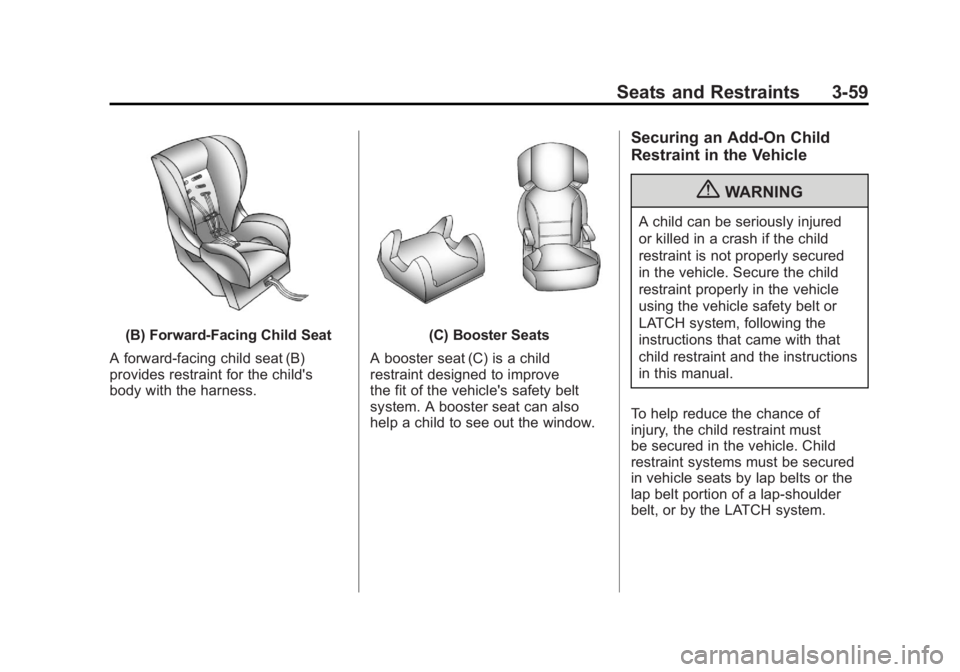
Black plate (59,1)GMC Yukon/Yukon XL Owner Manual - 2011
Seats and Restraints 3-59
(B) Forward-Facing Child Seat
A forward-facing child seat (B)
provides restraint for the child's
body with the harness.(C) Booster Seats
A booster seat (C) is a child
restraint designed to improve
the fit of the vehicle's safety belt
system. A booster seat can also
help a child to see out the window.
Securing an Add-On Child
Restraint in the Vehicle
{WARNING
A child can be seriously injured
or killed in a crash if the child
restraint is not properly secured
in the vehicle. Secure the child
restraint properly in the vehicle
using the vehicle safety belt or
LATCH system, following the
instructions that came with that
child restraint and the instructions
in this manual.
To help reduce the chance of
injury, the child restraint must
be secured in the vehicle. Child
restraint systems must be secured
in vehicle seats by lap belts or the
lap belt portion of a lap-shoulder
belt, or by the LATCH system.
Page 120 of 528
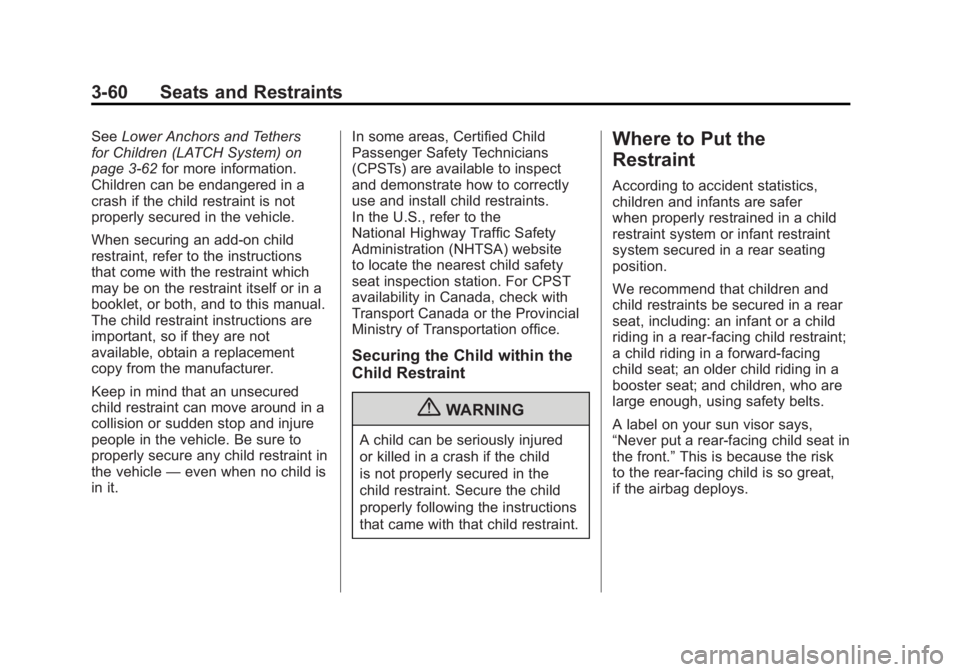
Black plate (60,1)GMC Yukon/Yukon XL Owner Manual - 2011
3-60 Seats and Restraints
SeeLower Anchors and Tethers
for Children (LATCH System) on
page 3‑62 for more information.
Children can be endangered in a
crash if the child restraint is not
properly secured in the vehicle.
When securing an add-on child
restraint, refer to the instructions
that come with the restraint which
may be on the restraint itself or in a
booklet, or both, and to this manual.
The child restraint instructions are
important, so if they are not
available, obtain a replacement
copy from the manufacturer.
Keep in mind that an unsecured
child restraint can move around in a
collision or sudden stop and injure
people in the vehicle. Be sure to
properly secure any child restraint in
the vehicle —even when no child is
in it. In some areas, Certified Child
Passenger Safety Technicians
(CPSTs) are available to inspect
and demonstrate how to correctly
use and install child restraints.
In the U.S., refer to the
National Highway Traffic Safety
Administration (NHTSA) website
to locate the nearest child safety
seat inspection station. For CPST
availability in Canada, check with
Transport Canada or the Provincial
Ministry of Transportation office.
Securing the Child within the
Child Restraint
{WARNING
A child can be seriously injured
or killed in a crash if the child
is not properly secured in the
child restraint. Secure the child
properly following the instructions
that came with that child restraint.
Where to Put the
Restraint
According to accident statistics,
children and infants are safer
when properly restrained in a child
restraint system or infant restraint
system secured in a rear seating
position.
We recommend that children and
child restraints be secured in a rear
seat, including: an infant or a child
riding in a rear-facing child restraint;
a child riding in a forward-facing
child seat; an older child riding in a
booster seat; and children, who are
large enough, using safety belts.
A label on your sun visor says,
“Never put a rear-facing child seat in
the front.”
This is because the risk
to the rear-facing child is so great,
if the airbag deploys.
Page 122 of 528
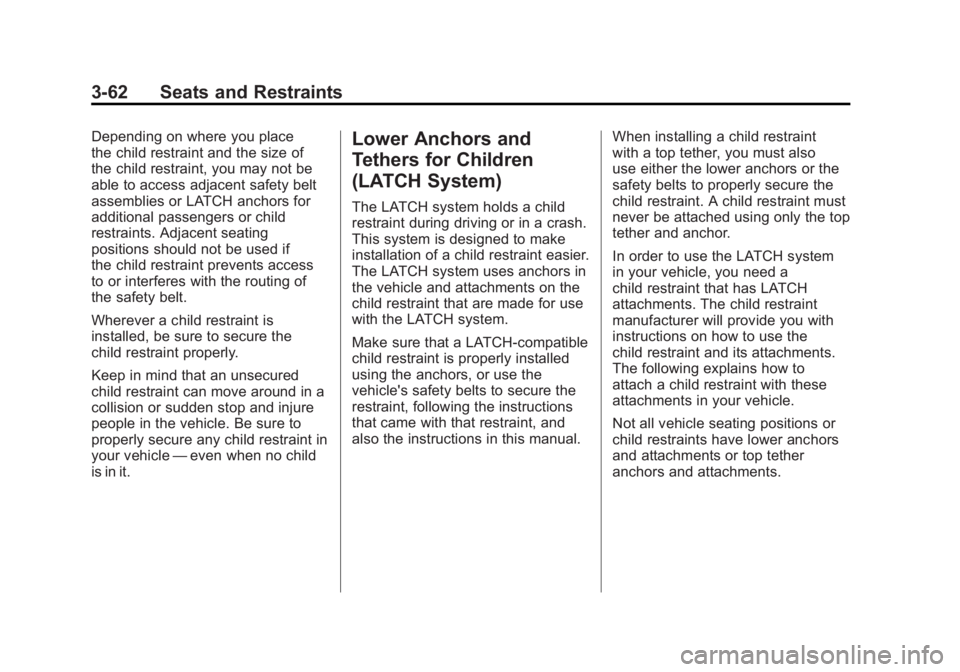
Black plate (62,1)GMC Yukon/Yukon XL Owner Manual - 2011
3-62 Seats and Restraints
Depending on where you place
the child restraint and the size of
the child restraint, you may not be
able to access adjacent safety belt
assemblies or LATCH anchors for
additional passengers or child
restraints. Adjacent seating
positions should not be used if
the child restraint prevents access
to or interferes with the routing of
the safety belt.
Wherever a child restraint is
installed, be sure to secure the
child restraint properly.
Keep in mind that an unsecured
child restraint can move around in a
collision or sudden stop and injure
people in the vehicle. Be sure to
properly secure any child restraint in
your vehicle—even when no child
is in it.Lower Anchors and
Tethers for Children
(LATCH System)
The LATCH system holds a child
restraint during driving or in a crash.
This system is designed to make
installation of a child restraint easier.
The LATCH system uses anchors in
the vehicle and attachments on the
child restraint that are made for use
with the LATCH system.
Make sure that a LATCH-compatible
child restraint is properly installed
using the anchors, or use the
vehicle's safety belts to secure the
restraint, following the instructions
that came with that restraint, and
also the instructions in this manual. When installing a child restraint
with a top tether, you must also
use either the lower anchors or the
safety belts to properly secure the
child restraint. A child restraint must
never be attached using only the top
tether and anchor.
In order to use the LATCH system
in your vehicle, you need a
child restraint that has LATCH
attachments. The child restraint
manufacturer will provide you with
instructions on how to use the
child restraint and its attachments.
The following explains how to
attach a child restraint with these
attachments in your vehicle.
Not all vehicle seating positions or
child restraints have lower anchors
and attachments or top tether
anchors and attachments.
Page 126 of 528
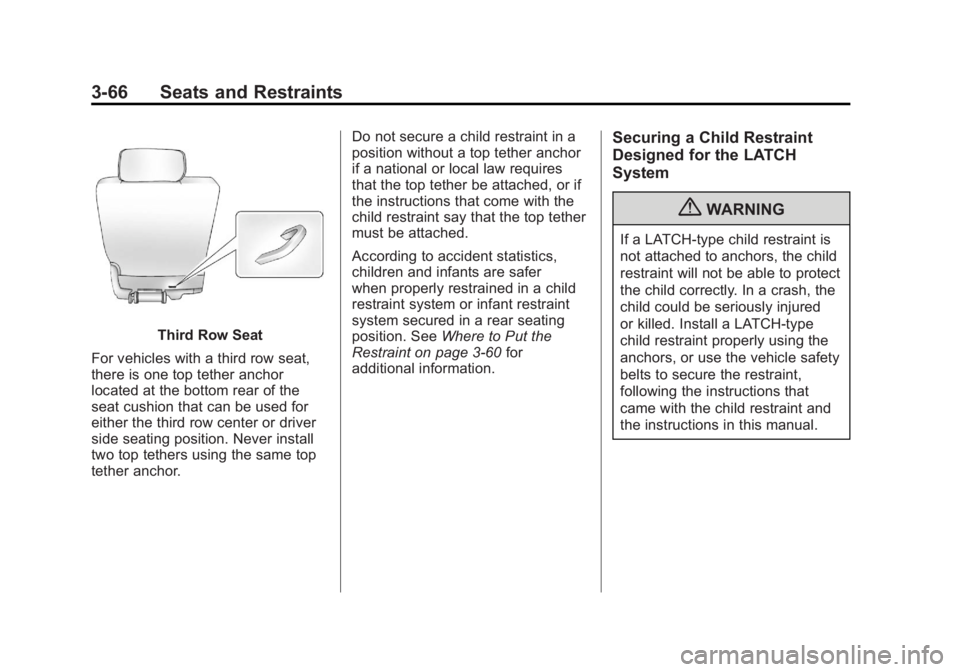
Black plate (66,1)GMC Yukon/Yukon XL Owner Manual - 2011
3-66 Seats and Restraints
Third Row Seat
For vehicles with a third row seat,
there is one top tether anchor
located at the bottom rear of the
seat cushion that can be used for
either the third row center or driver
side seating position. Never install
two top tethers using the same top
tether anchor. Do not secure a child restraint in a
position without a top tether anchor
if a national or local law requires
that the top tether be attached, or if
the instructions that come with the
child restraint say that the top tether
must be attached.
According to accident statistics,
children and infants are safer
when properly restrained in a child
restraint system or infant restraint
system secured in a rear seating
position. See
Where to Put the
Restraint on page 3‑60 for
additional information.
Securing a Child Restraint
Designed for the LATCH
System
{WARNING
If a LATCH-type child restraint is
not attached to anchors, the child
restraint will not be able to protect
the child correctly. In a crash, the
child could be seriously injured
or killed. Install a LATCH-type
child restraint properly using the
anchors, or use the vehicle safety
belts to secure the restraint,
following the instructions that
came with the child restraint and
the instructions in this manual.
Page 127 of 528
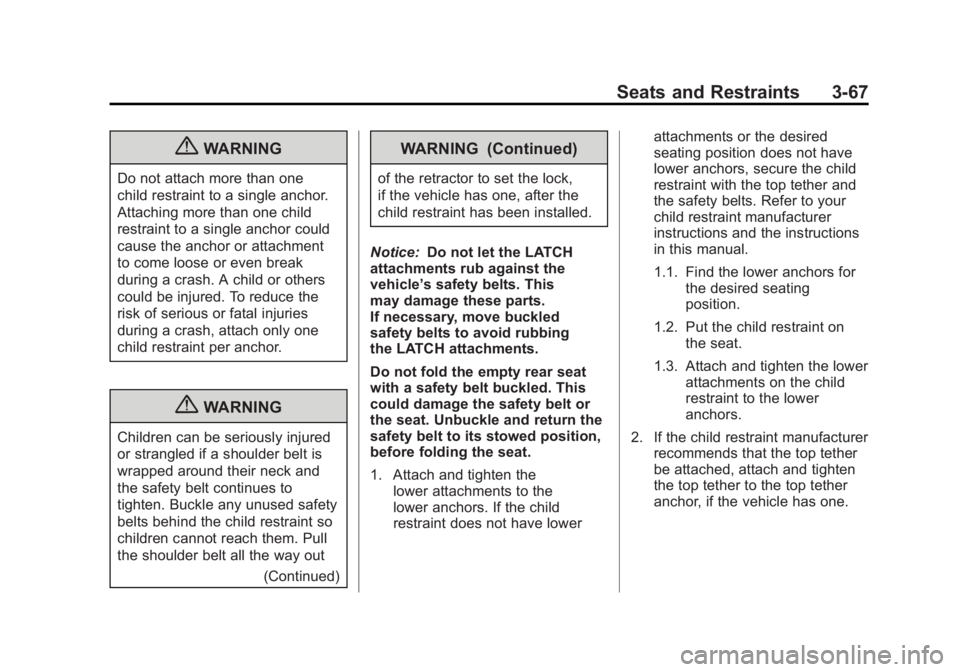
Black plate (67,1)GMC Yukon/Yukon XL Owner Manual - 2011
Seats and Restraints 3-67
{WARNING
Do not attach more than one
child restraint to a single anchor.
Attaching more than one child
restraint to a single anchor could
cause the anchor or attachment
to come loose or even break
during a crash. A child or others
could be injured. To reduce the
risk of serious or fatal injuries
during a crash, attach only one
child restraint per anchor.
{WARNING
Children can be seriously injured
or strangled if a shoulder belt is
wrapped around their neck and
the safety belt continues to
tighten. Buckle any unused safety
belts behind the child restraint so
children cannot reach them. Pull
the shoulder belt all the way out(Continued)
WARNING (Continued)
of the retractor to set the lock,
if the vehicle has one, after the
child restraint has been installed.
Notice: Do not let the LATCH
attachments rub against the
vehicle’ s safety belts. This
may damage these parts.
If necessary, move buckled
safety belts to avoid rubbing
the LATCH attachments.
Do not fold the empty rear seat
with a safety belt buckled. This
could damage the safety belt or
the seat. Unbuckle and return the
safety belt to its stowed position,
before folding the seat.
1. Attach and tighten the lower attachments to the
lower anchors. If the child
restraint does not have lower attachments or the desired
seating position does not have
lower anchors, secure the child
restraint with the top tether and
the safety belts. Refer to your
child restraint manufacturer
instructions and the instructions
in this manual.
1.1. Find the lower anchors for
the desired seating
position.
1.2. Put the child restraint on the seat.
1.3. Attach and tighten the lower attachments on the child
restraint to the lower
anchors.
2. If the child restraint manufacturer recommends that the top tether
be attached, attach and tighten
the top tether to the top tether
anchor, if the vehicle has one.
Page 129 of 528

Black plate (69,1)GMC Yukon/Yukon XL Owner Manual - 2011
Seats and Restraints 3-69
.If the position you are using
has a fixed or an adjustable
headrest or head restraint
and you are using a dual
tether, route the tether
around the headrest or
head restraint.
3. Before placing a child in the child restraint, make sure it
is securely held in place. To
check, grasp the child restraint
at the LATCH path and attempt
to move it side‐to‐side and
back‐and‐forth. There should
be no more than 2.5 cm (1 in)
of movement, for proper
installation.
Replacing LATCH System
Parts After a Crash
{WARNING
A crash can damage the
LATCH system in the vehicle.
A damaged LATCH system may
not properly secure the child
restraint, resulting in serious
injury or even death in a crash.
To help make sure the LATCH
system is working properly after
a crash, see your dealer to have
the system inspected and any
necessary replacements made
as soon as possible.
If the vehicle has the LATCH system
and it was being used during a
crash, new LATCH system parts
may be needed.
New parts and repairs may be
necessary even if the LATCH
system was not being used at the
time of the crash.
Securing Child Restraints
(Rear Seat Position)
When securing a child restraint
in a rear seating position, study
the instructions that came with the
child restraint to make sure it is
compatible with this vehicle.
If the child restraint has the
LATCH system, see Lower Anchors
and Tethers for Children (LATCH
System) on page 3‑62 for how and
where to install the child restraint
using LATCH. If a child restraint
is secured in the vehicle using a
safety belt and it uses a top tether,
see Lower Anchors and Tethers for
Children (LATCH System) on
page 3‑62 for top tether anchor
locations.
Do not secure a child seat in a
position without a top tether anchor
if a national or local law requires
that the top tether be anchored, or if
the instructions that come with the
child restraint say that the top strap
must be anchored.